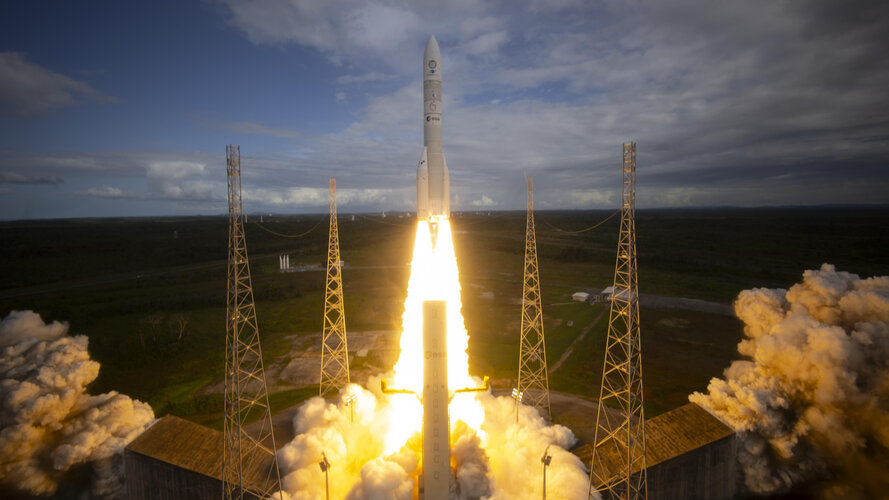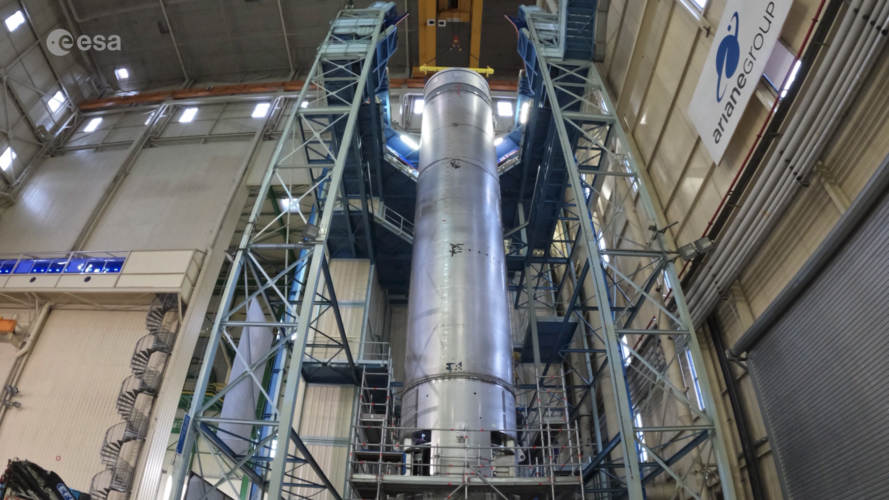James Parker, Leonid Capital Partners – Commercial Space Transformers
Tuesday, 17 December 2024 14:23

Image: Artemis II core stage moves to High Bay 2
Tuesday, 17 December 2024 14:11This request seems a bit unusual, so we need to confirm that you're human. Please press and hold the button until it turns completely green. Thank you for your cooperation!
Press and hold the button
If you believe this is an error, please contact our support team.
185.132.36.159 : 0fd095ac-be2c-45a7-a5c1-6606f8e1
Building concrete on Mars from local materials
Tuesday, 17 December 2024 13:19This request seems a bit unusual, so we need to confirm that you're human. Please press and hold the button until it turns completely green. Thank you for your cooperation!
Press and hold the button
If you believe this is an error, please contact our support team.
185.132.36.159 : 04a8df36-2988-4e65-bc95-68034ab4
NASA finalizes strategy for sustaining human presence in low Earth orbit
Tuesday, 17 December 2024 13:16This request seems a bit unusual, so we need to confirm that you're human. Please press and hold the button until it turns completely green. Thank you for your cooperation!
Press and hold the button
If you believe this is an error, please contact our support team.
185.132.36.159 : 618c9270-f68c-403a-9069-8db32766
ESA 2024 Highlights: flight of the Ariane 6
Tuesday, 17 December 2024 12:00 Video:
00:11:10
Video:
00:11:10
In 2024, ESA continued to drive Europe’s innovation and excellence in space, equipping the continent with advanced tools and knowledge to address global and local challenges. The year saw pioneering missions, cutting-edge satellites and the pivotal restoration of Europe’s independent access to space.
The first Ariane 6 launch was perhaps ‘the’ highlight of the year but it was only one of many achievements. We saw the last Vega launch and then the return to flight of Vega-C, the more powerful, upgraded version carrying Sentinel-1C.
Far away in our Solar System, the ESA/JAXA BepiColombo spacecraft performed twoMercury flybys in 2024, needed so that it can enter orbit around Mercury in 2026. Juice also performed a crucial gravity assist,
Fit-check timelapse: Themis reusable rocket stage demonstrator
Tuesday, 17 December 2024 12:00 Video:
00:01:20
Video:
00:01:20
In December 2024 the first Themis – Europe’s demonstrator of a reusable rocket first stage – completed a ‘full fit-check’ standing tall at ArianeGroup’s facility in Les Mureaux, France.
This step in the rocket development proves that all main elements fit together as planned, confirming the mechanical connections and interfaces from the lower to the upper parts of the rocket stage connect smoothly and as intended.
The 28-m tall model includes the main elements for Themis such as the engine bay, the fuel tanks, the flight control bay and the upper part. It is powered by the new-generation European Prometheus, an
SpaceX launches Space Force Rapid Response Trailblazer
Tuesday, 17 December 2024 11:47 US Space Force Space Systems Command (SSC) and Space Operations Command (SpOC) successfully executed a critical Rapid Response Trailblazer (RRT) mission in partnership with SpaceX. A Falcon 9 rocket launched the National Security Space Launch (NSSL) mission carrying the Global Positioning System (GPS) III space vehicle, SV-07, on Dec. 16 at 7:52 p.m. EST from Cape Canaveral Space Force Station,
US Space Force Space Systems Command (SSC) and Space Operations Command (SpOC) successfully executed a critical Rapid Response Trailblazer (RRT) mission in partnership with SpaceX. A Falcon 9 rocket launched the National Security Space Launch (NSSL) mission carrying the Global Positioning System (GPS) III space vehicle, SV-07, on Dec. 16 at 7:52 p.m. EST from Cape Canaveral Space Force Station, NASA endorses “continuous heartbeat” approach to human presence in LEO
Tuesday, 17 December 2024 10:53

Fit for service: Themis reusable rocket stage demonstrator
Tuesday, 17 December 2024 07:52 Image:
Fit for service: Themis reusable rocket stage demonstrator
Image:
Fit for service: Themis reusable rocket stage demonstrator Particle that only has mass when moving in one direction observed for first time
Tuesday, 17 December 2024 06:48 For the first time, scientists have observed a collection of particles, also known as a quasiparticle, that's massless when moving one direction but has mass in the other direction. The quasiparticle, called a semi-Dirac fermion, was first theorized 16 years ago, but was only recently spotted inside a crystal of semi-metal material called ZrSiS. The observation of the quasiparticle opens the doo
For the first time, scientists have observed a collection of particles, also known as a quasiparticle, that's massless when moving one direction but has mass in the other direction. The quasiparticle, called a semi-Dirac fermion, was first theorized 16 years ago, but was only recently spotted inside a crystal of semi-metal material called ZrSiS. The observation of the quasiparticle opens the doo Maxar and Satellogic partner to provide advanced EO for national security
Tuesday, 17 December 2024 06:48 Maxar Intelligence and Satellogic, Inc. (NASDAQ: SATL) have unveiled a new agreement designed to enhance the delivery of near real-time monitoring and change detection capabilities for U.S. national security missions and their international partners.
Under this tasking, data licensing, and distribution agreement, Maxar gains exclusive rights to direct task Satellogic's high-revisit satelli
Maxar Intelligence and Satellogic, Inc. (NASDAQ: SATL) have unveiled a new agreement designed to enhance the delivery of near real-time monitoring and change detection capabilities for U.S. national security missions and their international partners.
Under this tasking, data licensing, and distribution agreement, Maxar gains exclusive rights to direct task Satellogic's high-revisit satelli USSPACECOM emphasizes unified strategies for space operations advantage
Tuesday, 17 December 2024 06:48 Gen. Stephen Whiting, commander of U.S. Space Command, addressed the Space Force Association's annual Spacepower Conference on Dec. 11, highlighting the necessity of a unified operational strategy to maximize warfighting effectiveness in the space domain. Speaking to an audience of Guardians, government officials, academics, and space industry leaders, Whiting underscored the value of leveraging
Gen. Stephen Whiting, commander of U.S. Space Command, addressed the Space Force Association's annual Spacepower Conference on Dec. 11, highlighting the necessity of a unified operational strategy to maximize warfighting effectiveness in the space domain. Speaking to an audience of Guardians, government officials, academics, and space industry leaders, Whiting underscored the value of leveraging CSO outlines 'Space Force truths' during second-annual SFA Spacepower Conference
Tuesday, 17 December 2024 06:48 As the U.S. Space Force prepares to celebrate its fifth birthday, Chief of Space Operations Gen. Chance Saltzman reflected on the organization's remarkable journey and outlined the six core truths that shape the Guardian identity and the service's purpose.
Speaking at the second annual Spacepower Conference, Dec. 10 in Orlando, Saltzman emphasized the Space Force has come a long way since
As the U.S. Space Force prepares to celebrate its fifth birthday, Chief of Space Operations Gen. Chance Saltzman reflected on the organization's remarkable journey and outlined the six core truths that shape the Guardian identity and the service's purpose.
Speaking at the second annual Spacepower Conference, Dec. 10 in Orlando, Saltzman emphasized the Space Force has come a long way since First Japanese satellite with US payload prepared for launch
Tuesday, 17 December 2024 06:48 The first Japanese satellite carrying a U.S. payload has reached a critical milestone with its successful integration and readiness for delivery to the launch site at Tanegashima Space Center, Japan. This achievement marks a significant step in the U.S.-Japan partnership, coming just four years after the U.S. Space Force (USSF) and Japan's Cabinet Office signed a Memorandum of Understanding to c
The first Japanese satellite carrying a U.S. payload has reached a critical milestone with its successful integration and readiness for delivery to the launch site at Tanegashima Space Center, Japan. This achievement marks a significant step in the U.S.-Japan partnership, coming just four years after the U.S. Space Force (USSF) and Japan's Cabinet Office signed a Memorandum of Understanding to c 


